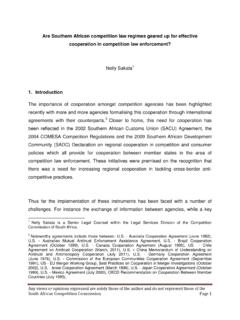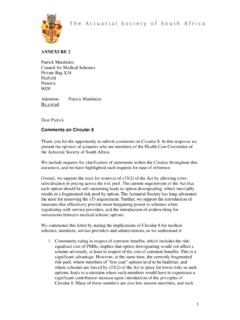Transcription of EFFICIENCY DISCOUNTED OPTIONS VALUE PROPOSITION
1 EFFICIENCY DISCOUNTED OPTIONS VALUE PROPOSITIONM ondi Govuzela06 July2017 Outline Section 29(1)(n) Silo-type benefit option frameworkContextWhat are EDOs?EDO FrameworkEDO construct demonstrationPerformance of EDOs Study objectives & approachPreliminary observations1/26/20182 Context The medical schemes Act and its regulations are aimed at, amongst others, protecting the interests of medical scheme beneficiaries at all times, including ensuring that medical schemes are affordable and provide equitable access. medical scheme contribution rates have been increasing at above-inflation rates for as long as anyone cares to remember affordability under pressure The existing silo-type benefit option framework for medical schemes allows for de facto risk-related pricing for common benefits offered by medical schemes .
2 This contradicts the intention of the medical schemes Act, as well as of health policy in general. Section 29(1)(n) of the Act limits the potential pricing configurations for medical schemes to variations in income or number of dependants. This limitation, for instance, prohibits the Council from registering arrangements where pricing varies exclusively on the basis of alternative provider contracts. This prohibition is inappropriate and prevents schemes from creating and pricing benefits in a manner that promotes reasonable provider competition. Main sources: Circular 8 of 2006 CMS 2010 EFFICIENCY DISCOUNTS an assessment to assist with exemption applications Section 29(1)(n) 29.
3 Matters for which rules shall provide. (1) The Registrar shall not register a medical scheme under section 24, and no medical scheme shall carry on any business, unless provision is made in its rules for the following matters: .. (n) The terms and conditions applicable to the admission of a person as a member and his or her dependants, which terms and conditions shall provide for the determination of contributions on the basis of income or the number of dependantsor both the income and the number of dependants, and shall not provide for any other grounds, including age, sex, past or present state of health, of the applicant or one or more of the applicant s dependants.
4 The frequency of rendering of relevant health services to an applicant or one or more of the applicant s dependantsother than for the provisions as prescribed. Purpose of Section 29(1)(n) The central purpose of section 29(1)n is to promote access to medical scheme membership through enhanced risk-pooling. If schemes were permitted to discriminate using contributions, it would not be possible for many to remain in cover after developing a chronic condition or when older. Challenges with Section 29(1)(n) Section 29(1)(n) does not allow instances where differential contribution rates may enhance participation and even contribute to reduced medical expenses.
5 Such an instance occurs where the sole purpose for the differential contribution (or discount) is to offer members a more efficient choice of medical service providers while continuing to offer contributions that do not vary with the risk profile of any beneficiary. Could the more efficient medical services not be offered through the registration of a new benefit option? New option must be self sustaining Priced on the health status of the group joining it The failure to attract large groups of people, especially sicker people, into more efficient provider arrangements undermines the ability of schemes to set them up in the first place.
6 Silo-type benefit option framework An arrangement with multiple benefit OPTIONS within a medical scheme presents a number of challenges. First, it is likely to compromise the principle of risk pooling. Risk pooling ensures that the burdensome risk of high cost of healthcare intervention is borne by all members of the pool and not individuals. Small risk pools are likely to result in low collection of resources to fund healthcare expenses and consequently a reduction of benefits or collapse of benefit OPTIONS Secondly, the voluntary nature of medical scheme membership is likely to cause a problem for the attainment of sufficient risk pooling in medical schemes .
7 This environment is likely to incentivise the young and healthy uninsured to stay out of the medical scheme coverage until a health need arises. Silo-type benefit option framework Thirdly, the environment with multiple OPTIONS within a medical scheme may provide medical schemes with an opportunity to manipulate healthcare plans. Plan manipulation occurs when insurers design benefit OPTIONS such that certain risk profiles have more incentive to purchase one set of healthcare plans over others Purchasers of healthcare are likely to have different needs and as a result are expected to have dissimilar preferences for different types of healthcare insurance.
8 Logically, medical schemes are expected to develop benefit OPTIONS that accommodate these preferences as far as possible. Factors that influence choice of benefit option include premium and income, age, family composition and health status. Furthermore, beneficiaries are likely to choose benefit OPTIONS on the basis of expected healthcare utilisation. It is within this context that CMS as the regulator investigates and develops policies/guidelines that are aimed at ensuring that medical schemes are affordable and provide equitable Framework Through an exemption framework, allow schemes to reward more sickly members, through a contribution discount, for choosing a more cost-efficient provider arrangement.
9 The framework gives the schemes the ability to identify providers that have proven to be more cost effective and efficient in providing healthcare services than the current provider arrangement. The savings are passed on the members in the form of monthly premium discount. For the purposes of establishing whether an exemption is justified, it is possible merely to assess whether the discount accrues to a sicker risk profile or a healthier risk profile. If the former then it is a true EFFICIENCY discount. If the latter it is not. EDO construct demonstration EDO Scenarios Performance of EDOs in 2015 Eight schemes (Momentum, DHMS, Fedhealth, Liberty, Thebemed, Compcare, Medihelp, and Bestmed) collectively offer 42 EDOs covering 233 106 member (487 659 beneficiaries).
10 Total contribution income for EDOs was approximately billion ( for non-EDOs). The claims ratio for EDOs was ( non-EDOs) resulting in a net healthcare result of PBPM ( non-EDOs).Performance of EDOs in 2015 (cont.) The average age per beneficiary for EDOs is ( for non-EDOs). The pensioner ratio for EDOs is 5,1% whilst that for non-EDOs is Age and pensioner ratio is well known to have a significant impact on healthcare expenditure. Gross contribution increases for EDOs ( ) vs non-EDOs ( ) (2014 to 2015, Annexure T)Study objectiveAssess and evaluate the VALUE PROPOSITION for EFFICIENCY DISCOUNTED OptionsStudy approach Literature review VALUE in health care EFFICIENCY in health care Quality in health care Strategic purchasing Document review MSA, circulars, CMS EDO guideline, EDO business plans, scheme rules Statistical analysis Descriptive analysis Pairwise and overall comparison of benefit OPTIONS to determine the VALUE PROPOSITION of the EDO benefit OPTIONS (cost, contributions, difference in risk profiles and utilisation of healthcare services)










